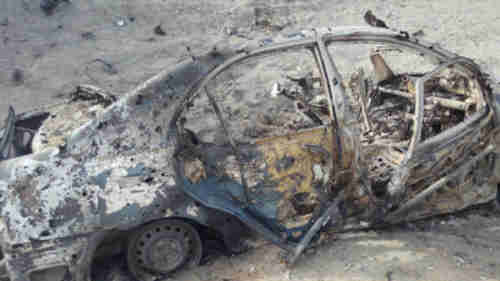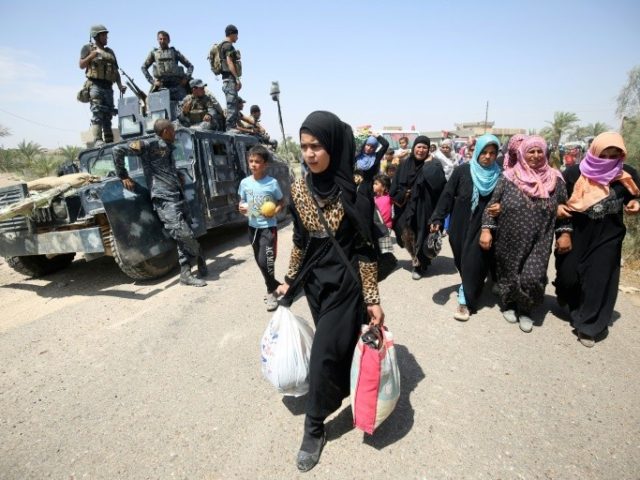This morning’s key headlines from GenerationalDynamics.com
- Death of Afghan Taliban leader exposes Iran-Taliban links
- 50,000 civilians in danger as Iraq tries to liberate Fallujah from ISIS
Death of Afghan Taliban leader exposes Iran-Taliban links

Wreckage of vehicle in which Mansour was traveling when hit by US drone strike (Anadolu)
As we reported earlier this month, Afghan Taliban leader Mullah Akhtar Mohammad Mansour was killed by a US drone strike as he was traveling by car in Pakistan’s Balochistan province, not far from the border with Iran.
It now turns out that Mansour’s car was returning from a trip to Iran. Iran’s foreign ministry has said, “The concerned authorities in Iran reject that such a person had entered Pakistan via Iran’s border at the stated date,” but Western reporters arriving at the site of the drone strike have seen Mansour’s Pakistani passport, with entry and exit stamps showing that he had traveled into Iran and back again that day.
It is not known where or why Mansour went inside Iran. It is not known whether he had some secret relationship with Iran’s government, or whether he was just visiting Taliban cells within Iran, without Iran’s knowledge.
However, this discovery has generated some examination of Iran’s relationship with the Taliban. Iran is a hardline Shia state, and the Taliban is a hardline Sunni organization, so their relationship could never be more than a “marriage of convenience” that could be dissolved by either side at any time.
Iran had staunchly opposed the Taliban in the 1990s and had almost gone to war with it after Taliban forces massacred Iranian diplomats and local Shia Muslims in the Afghan city of Mazar-e Sharif in 1998. Since 9/11, there has been some cooperation between Iran and the Taliban over the US presence in Afghanistan.
Since 2014, when the so-called Islamic State (IS or ISIS or ISIL or Daesh) began to infiltrate Afghanistan, Iran and the Taliban have shared a common interest in wanting to repel ISIS.
There are still plenty of unanswered questions about the drone strike that killed Mansour. Mansour’s whereabouts were a closely guarded secret, and yet US intelligence officials were apparently absolutely certain, at the time of the drone strike, that they knew what car he was traveling in. How did they know?
James Cunningham, a former US ambassador to Afghanistan says:
Pick your conspiracy theory. How did his passport survive? Did [ISIS] shop him to the US? Did the Iranians tip us off? We likely will never know. But the Taliban must be wondering, too.
What needs to be debunked is the Pakistani line that Afghanistan is the fault of the United States and the international community, and that the killing [of Mansour] blocks the [Afghan-Taliban] peace process. “There is no peace process; Mansour made clear there was no intent to negotiate.
Guardian (London) and VOA and Al Monitor
50,000 civilians in danger as Iraq tries to liberate Fallujah from ISIS
American Marines endured some of the bloodiest fighting of the Iraq War in Fallujah in 2003-2004, fighting against Al-Qaeda in Iraq (AQI). After the “surge” in 2007, AQI was expelled from Iraq, including Fallujah, but the withdrawal of all American forces in 2011 created a vacuum that was filled by the so-called Islamic State (IS or ISIS or ISIL or Daesh). ISIS captured large swaths of Iraqi territory, including Fallujah in 2014, and now there is a new battle of Fallujah, fought mainly by ISIS against Iraqi army forces, the latter backed by US airstrikes.
Baghdad has been hit by a seemingly unending stream of terrorist attacks and bombings that have killed hundreds of civilians in recent months. Fallujah is 40 miles west of Baghdad, and ISIS has been using it as a base to launch these attacks. The Iraq government sees the recapture of Fallujah as key to stopping these attacks and stopping ISIS itself.
For more than a week, Iraqi forces have been surrounding Fallujah and preparing for troops to enter the city, and now the battle was finally launched on Tuesday. The ISIS forces have no way to escape, and so the fighting is fierce.
It is feared that a massive humanitarian disaster is in the making. The problem is that there are also 50,000 civilians in the city, and many have no way to escape either, though they have been advised to flee. ISIS forces have booby trapped many of the roads and buildings and they’re using civilians as “human shields,” hoping to slow down the Iraqi forces.
Iraq is increasingly facing a huge internal refugee problem, with hundreds of thousands of Iraqis forced to flee their homes in one battle after another. If the Iraq army ever attempts to liberate Mosul from ISIS, that will put its 600,000 civilians at risk.
There is a related issue that is growing in complexity. Since the invasion by ISIS, many of the internally displaced Iraqi civilians have fled to the relative safety and security of the Kurdistan Region of Iraq (KRI). The KRI is supposed to hold a reference on independence later this year, something that the Iraq government opposes, and it’s possible that the Iraq government is not unhappy that a huge influx of Iraqi Arab refugees will complicate the referendum. Rudaw (Iraq/Kurds) and USA Today and VOA and Chatham House (London)
KEYS: Generational Dynamics, Afghanistan, Taliban, Mullah Akhtar Mohammad Mansour, Pakistan, Balochistan, Iran, James Cunningham, Islamic State / of Iraq and Syria/Sham/the Levant, IS, ISIS, ISIL, Daesh, Iraq, Fallujah, al-Qaeda in Iraq, AQI, Kurdistan Region of Iraq, KRI
Permanent web link to this article
Receive daily World View columns by e-mail

COMMENTS
Please let us know if you're having issues with commenting.